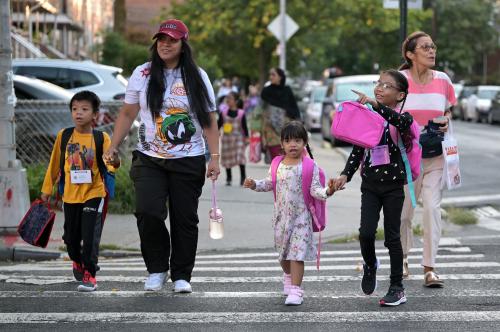In 2012, Deferred Action for Childhood Arrivals (DACA) provided legal protection and work authorization for over 650,000 undocumented youth living in the U.S. who were enrolled in school or had completed high school. As one of the most significant immigration reforms in recent years, DACA remains central to immigration policy debates, particularly amid fluctuating administrative actions attempting to cancel or reinstate the program.
With immigration front and center in this year’s election, it’s important to know what research tells us about the effects of policies such as DACA. In fact, we now have considerable—and growing—evidence on DACA, and that evidence tells a largely positive story.
Prior research has shown that DACA eligibility improves employment, health, and housing outcomes. The effects on educational attainment are more nuanced, depending on when youth first became DACA-eligible. Those eligible at later ages show decreased college enrollment, likely due to improved job prospects. Conversely, those exposed to DACA earlier demonstrate higher high school completion rates.
In recently published research, I delve deeper into DACA’s educational impacts. Drawing on comprehensive administrative schooling data, I explore not only educational attainment among DACA-eligible youth exposed at younger ages, but also high school effort and behavioral outcomes. My study goes beyond the direct effects on undocumented students to explore spillover impacts on their U.S.-born peers. I find that DACA improves test scores and educational attainment not only for those directly eligible but also for their peers. These findings provide a broader view of DACA’s impacts, offering insights into how early exposure to legal protection shapes educational trajectories for both immediate beneficiaries and the wider school community.
Background
DACA status represents a profound shift for undocumented youth, especially those exposed to the policy at younger ages. First, being eligible for DACA during high school creates strong incentives to complete high school, as the policy requires applicants to be either enrolled or have completed high school if they wish to receive DACA protections. Second, DACA could have motivated undocumented youth to invest more effort in their high school education, knowing that the temporary protection from deportation and access to work permits could make higher education and better paying jobs more attainable.
The way that DACA was implemented also presents opportunities for careful research. Abrupt changes in the returns to schooling for a specific group, like those brought about by DACA, can help us see how changes in the returns to schooling for one group of students might affect other groups. For instance, increased effort among undocumented students could have positive spillover effects if it leads U.S.-born students to focus more on—or invest more in—their education. Conversely, the program could negatively affect U.S.-born students if DACA-eligible students consume limited educational resources that otherwise would have benefited U.S.-born students. Understanding these dynamics is essential as policymakers debate the future of DACA and related immigration reforms.
DACA’s impact in Los Angeles
I examined the direct and spillover effects of DACA on human capital investments during high school. My setting is Los Angeles, where I use detailed schooling records from Los Angeles Unified School district (LAUSD). Los Angeles is home to the largest percentage of DACA-eligible youth in the U.S. Moreover, it is a school district that was characterized by relatively low educational attainment relative to the rest of the U.S. at the time of DACA’s enactment, with many students on the margin of high school completion. This provides an ideal setting to test whether DACA’s minimum education requirements had any impact on students’ educational outcomes.
My methodological approach is based on the enactment of DACA in 2012, which increased the value of a high school diploma for undocumented youth but left the returns for U.S.-born students unchanged. I assess whether DACA led to increases in high school enrollment, completion, and educational effort among likely-undocumented youth in Los Angeles (determined based on the concentration of DACA applicants in foreign-born students’ home zip code).1 To understand whether DACA had any spillover effects on U.S.-born students, I compare the educational outcomes of U.S.-born students in schools with higher and lower concentrations of likely DACA-eligible peers before and after DACA’s enactment.
There are three main findings from this work:
- Increased educational attainment for undocumented children: DACA led to significant increases in the educational investments of likely undocumented youth. High school graduation rates increased by 12%. This was driven primarily by male students and those initially at higher risk of dropping out.
- Improved academic performance for undocumented children: There were significant improvements in English Language Arts (ELA) achievement among likely undocumented youth, with ELA test scores increasing by 0.15 standard deviations. This suggests that the increase in educational attainment was accompanied by an increase in effort and motivation, likely driven by a perceived improvement in the returns on education. These increases in test scores are meaningful (in education studies, a 0.15 standard deviation increase is generally considered a moderate effect size) and are comparable to other studies that analyze the academic effects of citizenship policies on immigrant children.
- Positive spillover effects on U.S.-born students: The increased educational investments among likely undocumented youth had positive spillover effects on their U.S.-born peers. At the average high school campus, where 3.4 percent of students were likely undocumented, DACA’s introduction resulted in a two-percentage-point (or four percent) increase in U.S.-born students’ probability of high school completion. U.S.-born students also experienced an increase in ELA achievement (0.06 standard deviations) after DACA’s enactment. The magnitudes of these spillover effects align with the literature on peer effects and tend to be on the larger end, most closely resembling studies that focus on significant changes in peer achievement composition.
Implications and future directions
Understanding how DACA’s introduction influenced the trajectories of undocumented youth and their peers is crucial for policymakers. As DACA remains central to immigration policy debates, my findings offer compelling evidence that policies providing legal protection and enhancing the returns to schooling for undocumented youth can significantly improve educational outcomes—not only for those directly eligible but also for their U.S.-born peers.
While Los Angeles serves as an ideal setting for studying DACA’s impacts, the strong presence of immigration rights groups and extensive outreach activities may not be representative of all regions. DACA’s impacts could differ in areas less supportive of such policies, and additional research in these areas is needed.
Nonetheless, my research highlights that immigration policies can benefit entire communities, enhancing student outcomes beyond their intended recipients. These broader community benefits highlight the pivotal role immigration reform can play in improving social mobility for all.
-
Footnotes
- More specifically, I take the total number of DACA applicants residing in a zip code and divide by the number of foreign-born youth living in that zip code at the time DACA was enacted. Since DACA take-up rates were particularly high in Los Angeles, this method likely provides an accurate estimate of the proportion of foreign-born students who are DACA-eligible, minimizing measurement error in estimating likely DACA eligibility.







Commentary
Research shows that DACA benefits both Dreamers and their US-born peers
October 7, 2024